Structure and composition of carbon nanostructures produced by different methods
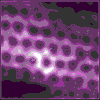 Carbon nanostructures produced by Carbon nanostructures produced by - catalytic decomposition of acetylene
- high energy ion implantation
- fullerene decomposition
- laser ablation
were investigated by scanning probe (STM and AFM) and TEM methods. The images are studied by computer simulation. Apart from single- and multiwall nanotubes more exotic forms (Y-branchings and coils) were also found. The precise atomic structure and formation of these is investigated.
Publications >> |
Nanostructures produced by high energy (E > 100 MeV) heavy irradiation
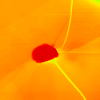 In Highly Oriented Pyrolythic Graphite (HOPG) irradiated by ~200 MeV Kr and U ions both electronic and nuclear stopping processes are present. Carbon nanotubes were found on all irradiated HOPG samples. STM images show an atomic arrangement identical of graphite. AFM revealed sputtering craters from which the nanotubes emerge. Vibration of some nanotubes was observed. In Highly Oriented Pyrolythic Graphite (HOPG) irradiated by ~200 MeV Kr and U ions both electronic and nuclear stopping processes are present. Carbon nanotubes were found on all irradiated HOPG samples. STM images show an atomic arrangement identical of graphite. AFM revealed sputtering craters from which the nanotubes emerge. Vibration of some nanotubes was observed.
Publications >> |
Tunneling through carbon nanostructures
 Interpretation of experimental STM images and STS curves of carbon nanostructures is delicate because several effects contribute to the electron tunneling through these supported structures, including: Interpretation of experimental STM images and STS curves of carbon nanostructures is delicate because several effects contribute to the electron tunneling through these supported structures, including: - Tip convolution
- Effect of the second tunnel gap (between nanostructure and its support)
- Point contact effects
- Electronic structure
These processes were investigated by our wave packet dynamical computer code and by tight-binding calculations. Results compare well with experiments.
Publications >> |
Continuous carbon nanotube production in underwater AC electric arc
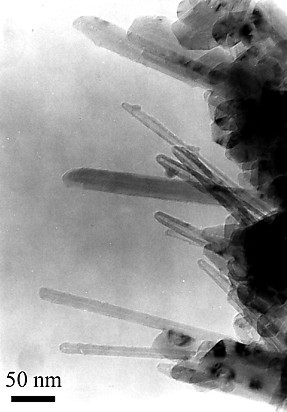 We developed a simple, low cost and continuous growth method for the production of well graphitized multi-wall carbon nanotubes. In our procedure we combine the underwater growth with the use of an AC power supply and computer control. We developed a simple, low cost and continuous growth method for the production of well graphitized multi-wall carbon nanotubes. In our procedure we combine the underwater growth with the use of an AC power supply and computer control.
An AC electric arc is generated between two identical carbon rods of 6 mm in diameter, submerged in deionized water. Two computer controlled stepper motors are used to regulate the distance between the electrodes. At a voltage of 40 V the arc is stable in the range of 85–45 A. At lower current values higher fraction of carbon nanotubes is obtained in the product.
Publications >> |
Nanotubes from fullerene decomposition
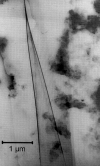 The decomposition of C60 fullerene in a stainless steel oven at 450 C was demonstrated. Carbon fragments Cn , with n<20, were observed in the oven vapour. The low temperature carbon beam emitted from the oven condensed to form carbon nanotubes on HOPG surfaces with diameters in the range of 5-20 nm. No nanotubes were found from a heated quartz cartridge or on gold substrates. The decomposition of C60 fullerene in a stainless steel oven at 450 C was demonstrated. Carbon fragments Cn , with n<20, were observed in the oven vapour. The low temperature carbon beam emitted from the oven condensed to form carbon nanotubes on HOPG surfaces with diameters in the range of 5-20 nm. No nanotubes were found from a heated quartz cartridge or on gold substrates.
This procedure, of generating the carbon beam by C60 fullerene decomposition, has a number of advantages: - the process is a low temperature one
- no other atomic species e.g. H, He, N are involved
- the substrate temperature can be varied over a very large temperature range without influencing the generation of the carbon beam
Publications >> |
Coiled and branched carbon nanotubes
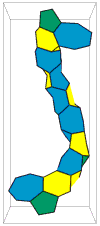 We study coiled, and Y-branched carbon nanotubes by STM, STS, TEM, and AFM. Their atomic and electronic structure is studied theoretically. We have proposed a new structural model similar to the Haeckaelite structures of Terrones et al, which, in contrast to earlier models have a supraunitary nonhexagonal to hexagonal ring ratio. We study coiled, and Y-branched carbon nanotubes by STM, STS, TEM, and AFM. Their atomic and electronic structure is studied theoretically. We have proposed a new structural model similar to the Haeckaelite structures of Terrones et al, which, in contrast to earlier models have a supraunitary nonhexagonal to hexagonal ring ratio.
Publications >> |
SPM methodology
 Acquisition of STM and AFM good images depends severely on the properties of the microtip, a cluster of 10-15 atoms. Often very different STM images are received from the same sample in atomic resolution. This can be explained by the different rotation angles of the active microtip around the tip axis. Acquisition of STM and AFM good images depends severely on the properties of the microtip, a cluster of 10-15 atoms. Often very different STM images are received from the same sample in atomic resolution. This can be explained by the different rotation angles of the active microtip around the tip axis.
Publications >> |
Photonic crystal type structures
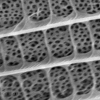 The coloration of buttery wings has two main sources: color arising from pigmentation, and color arising from the nanostructure of their wing scales. We study optical features and other properties of butterfly wing scales by physical methods. Nanostructures of the scales are clearly seen in STM images. The coloration of buttery wings has two main sources: color arising from pigmentation, and color arising from the nanostructure of their wing scales. We study optical features and other properties of butterfly wing scales by physical methods. Nanostructures of the scales are clearly seen in STM images.
Publications >> |
Education
 Our experimental and theoretical tools and expertise are actively utilized in education at several universities. Time dependent quantum mechanical scattering, which is traditionally a mathematically difficult subject, is demonstrated by simple computer animations. Our experimental and theoretical tools and expertise are actively utilized in education at several universities. Time dependent quantum mechanical scattering, which is traditionally a mathematically difficult subject, is demonstrated by simple computer animations.
Publications >> |
Miscalleneous
- Photon assisted implantation
- DOS calculations for alloys
- Crystal growth
- Ion implantation
- Thin films
- Software development
Publications >> |
